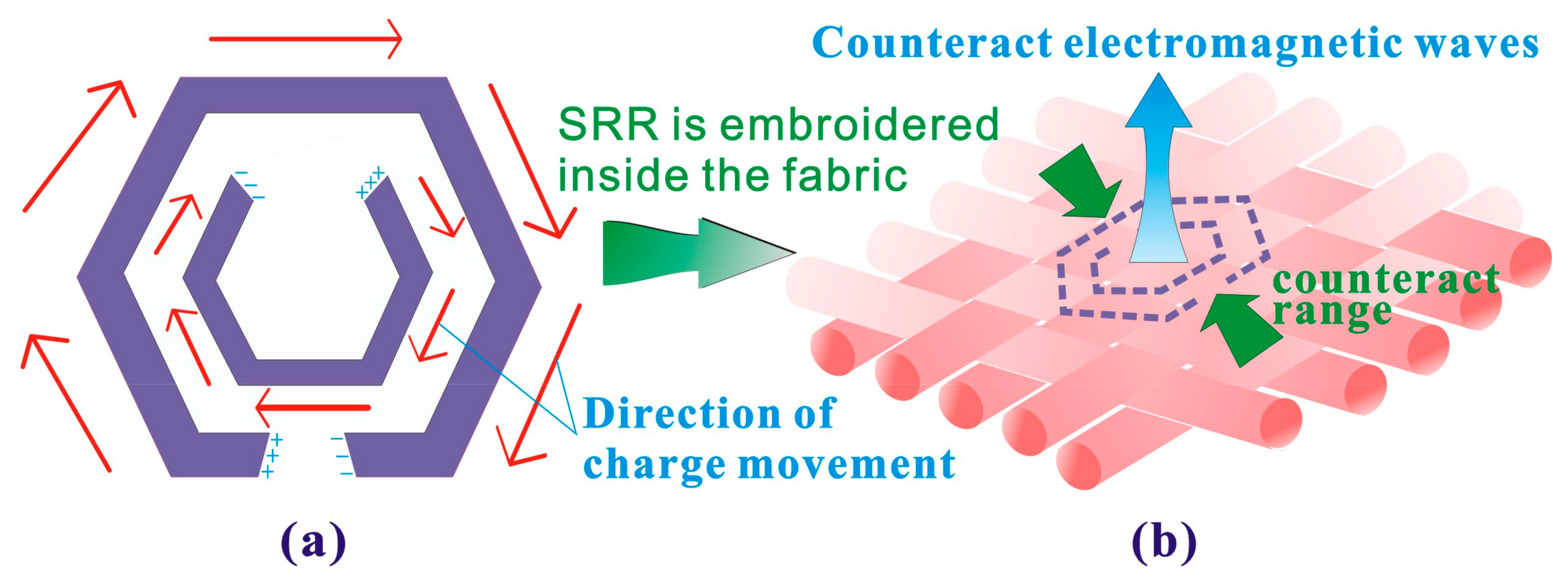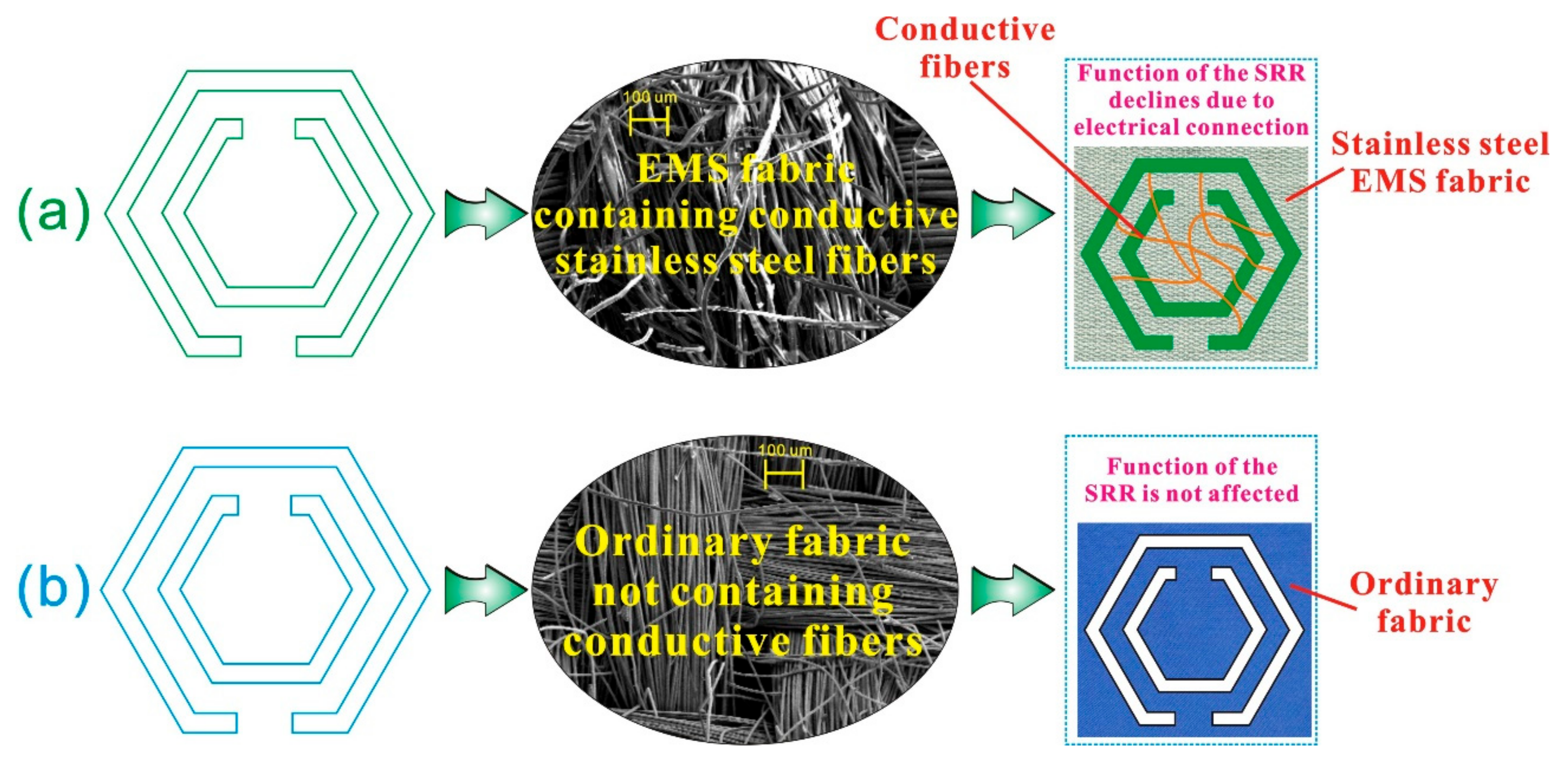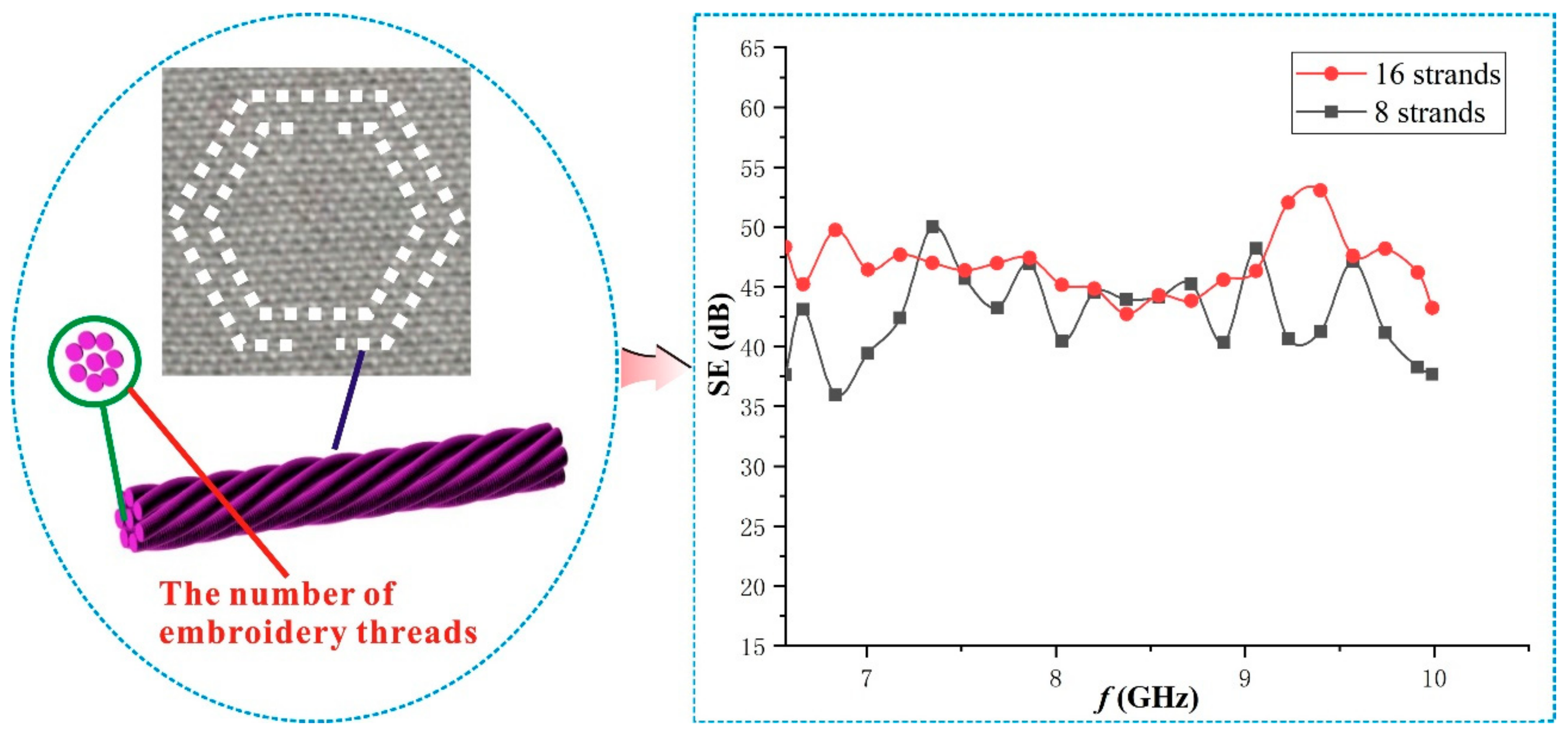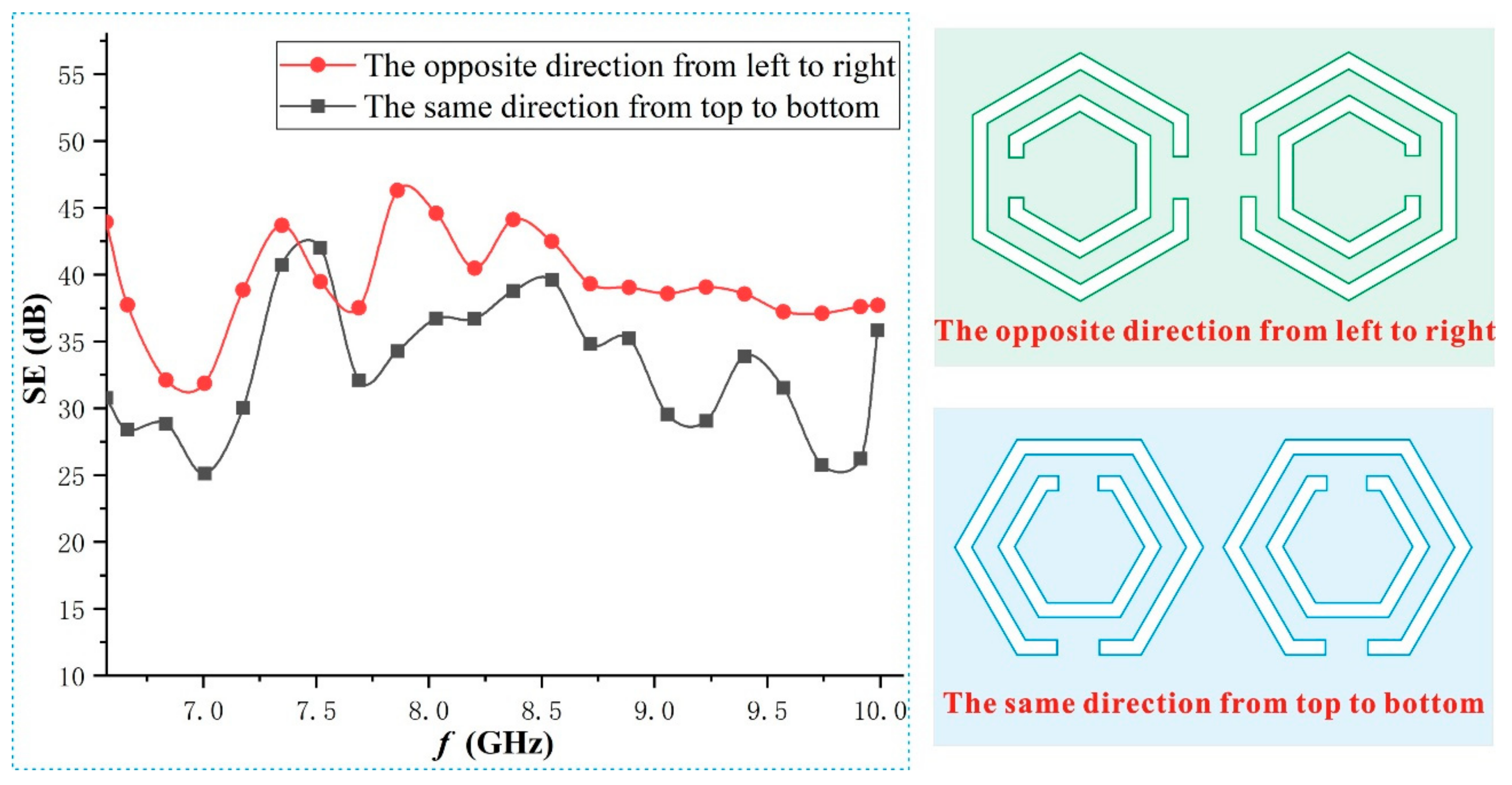Shielding Performance of Electromagnetic Shielding Fabric Implanted with “Split-Ring Resonator”
Abstract
1. Introduction
2. Experiment
2.1. Basic Ideas
2.2. Implantation Method of the SRR
2.3. Test Equipment
2.4. Experimental Materials
3. Results and Analysis
3.1. Effectiveness of the SRR Implantation
3.2. Influence of the Size of the SRR on the SE
3.3. Influence of the Number of Embroidery Threads of the SRR Implantation on the SE
3.4. Other Influencing Factors and Invalidity
4. Conclusions
- (1)
- The method of invisible embroidery can be used to implant SRRs with different parameters in the fabric with conductive fibers. The method does not form piercing holes in the fabric and reduces the adverse effects of the embroidery needle on the improvement of the SE of the fabric.
- (2)
- Implanting SRRs in the fabric could effectively improve the SE of the fabric. For the ordinary fabric, the SE was improved by about 32 dB at most and 11 dB at least. For the EMS fabric, the overall SE was significantly improved, and the improving range could reach between 6 dB and 15 dB.
- (3)
- The pattern size of the SRR had a certain effect on the SE of the fabric. The overall SE of the fabric decreased with the decrease of the outer diameter of the SRR. The decrease trend was sometimes fast and sometimes slow. For different frequency ranges, the decreasing amplitude was not consistent.
- (4)
- The number of embroidery threads of the SRR had a certain effect on the SE of the fabric. When other parameters remained unchanged, the increase of the number of embroidery threads increased the SE of the fabric, but the overall improvement was not significant.
- (5)
- There are many influencing factors of the SRR on the SE of the fabric, such as the opening size, the arrangement spacing, the quantity per unit area, the parameter compatibility, the embroidery method, the fabric type, and the frequency band. At the same time, the SRR will also lose efficacy under certain circumstances.
Author Contributions
Funding
Institutional Review Board Statement
Data Availability Statement
Conflicts of Interest
References
- Mannan, M.; Weldu, Y.W.; Al-Ghamdi, S.G. Health impact of energy use in buildings: Radiation propagation assessment in indoor environment. Energy Rep. 2020, 6, 915–920. [Google Scholar] [CrossRef]
- Liu, Z.; He, S.; Wang, H.; Wang, X. Improvement of the electromagnetic properties of blended electromagnetic shielding fabric of cotton/stainless steel/polyester based on multi-layer MXenes. Text. Res. J. 2022, 92, 1495–1505. [Google Scholar] [CrossRef]
- Wang, X.; Hang, G.; Liu, Z.; He, S. Study on finishing and electromagnetic properties of electromagnetic shielding fabric based on multilayer Ti3C2Tx medium. J. Text. Inst. 2021, 113, 2704–2713. [Google Scholar] [CrossRef]
- Liu, Z.; Wang, X. FDTD Numerical Calculation of Shielding Effectiveness of Electromagnetic Shielding Fabric Based on Warp and Weft Weave Points. Ieee Trans. Electromagn. Compat. 2020, 62, 1693–1702. [Google Scholar] [CrossRef]
- Yin, J.; Ma, W.; Gao, Z.; Lei, X.; Jia, C. A Structural Design Method of 3D Electromagnetic Wave-Absorbing Woven Fabrics. Polymers 2022, 14, 2635. [Google Scholar] [CrossRef] [PubMed]
- Zhang, X.L.; Jin, Z.M.; Hu, L.Z.; Zhou, X.Y.; Yang, K.; Kremenakova, D.; Militky, J. A Silver Yarn-Incorporated Song Brocade Fabric with Enhanced Electromagnetic Shielding. Materials 2021, 14, 16. [Google Scholar] [CrossRef] [PubMed]
- Pusic, T.; Saravanja, B.; Malaric, K.; Luburic, M.; Kaurin, T. Electromagnetic Shielding Effectiveness of Woven Fabric with Integrated Conductive Threads after Washing with Liquid and Powder Detergents. Polymers 2022, 14, 12. [Google Scholar] [CrossRef] [PubMed]
- Wang, X.C.; Liu, Z.; Wu, L.; Wang, Y.; Su, Y. Influencing factors and rules of shielding effectiveness of electromagnetic shielding clothing sleeve. Int. J. Cloth. Sci. Technol. 2021, 33, 241–253. [Google Scholar] [CrossRef]
- Toghchi, M.J.; Loghin, C.; Cristian, I.; Campagne, C.; Bruniaux, P.; Cayla, A.; Lucano, N.; Chen, Y. The effects of the structural parameters of three-dimensional warp interlock woven fabrics with silver-based hybrid yarns on electromagnetic shielding behavior. Text. Res. J. 2020, 90, 1354–1371. [Google Scholar] [CrossRef]
- Vohra, N.; El-Shenawee, M. K- and W-Band Free-Space Characterizations of Highly Conductive Radar Absorbing Materials. Ieee Trans. Instrum. Meas. 2021, 70, 1–10. [Google Scholar] [CrossRef]
- Uzun, S.; Han, M.K.; Strobel, C.J.; Hantanasirisakul, K.; Goad, A.; Dion, G.; Gogotsi, Y. Highly conductive and scalable Ti3C2Tx-coated fabrics for efficient electromagnetic interference shielding. Carbon 2021, 174, 382–389. [Google Scholar] [CrossRef]
- Tunakova, V.; Tunak, M.; Tesinova, P.; Seidlova, M.; Prochazka, J. Fashion clothing with electromagnetic radiation protection: Aesthetic properties and performance. Text. Res. J. 2020, 90, 2504–2521. [Google Scholar] [CrossRef]
- Yang, Y.L.; Wang, J.P.; Liu, Z.; Wang, Z.J. A new study on the influencing factors and mechanism of shielding effectiveness of woven fabrics containing stainless steel fibers. J. Ind. Text. 2021, 50, 830–846. [Google Scholar] [CrossRef]
- Kumar, S.; Kumar, P.; Gupta, R.; Verma, V. Electromagnetic interference shielding behaviors of in-situ polymerized ferrite-polyaniline nano-composites and ferrite-polyaniline deposited fabrics in X-band frequency range. J. Alloy. Compd. 2021, 862, 158331. [Google Scholar] [CrossRef]
- Hardy, W.N.; Whitehead, L.A. Split-Ring Resonator for Use in Magnetic-Resonance from 200-2000 mHz. Rev. Sci. Instrum. 1981, 52, 213–216. [Google Scholar] [CrossRef]
- Pendry, J.B.; Holden, A.J.; Stewart, W.J.; Youngs, I. Extremely low frequency plasmons in metallic mesostructures. Phys. Rev. Lett. 1996, 76, 4773–4776. [Google Scholar] [CrossRef]
- Dey, S.; Chatterjee, D.; Garboczi, E.J.; Hassan, A.M. Plasmonic Nanoantenna Optimization Using Characteristic Mode Analysis. Ieee Trans. Antennas Propag. 2020, 68, 43–53. [Google Scholar] [CrossRef]
- Qiu, C.-W.; Zhang, T.; Hu, G.; Kivshar, Y. Quo Vadis, Metasurfaces? Nano Lett. 2021, 21, 5461–5474. [Google Scholar] [CrossRef]
- Liang, Y.; Koshelev, K.; Zhang, F.; Lin, H.; Lin, S.; Wu, J.; Jia, B.; Kivshar, Y. Bound States in the Continuum in Anisotropic Plasmonic Metasurfaces. Nano Lett. 2020, 20, 6351–6356. [Google Scholar] [CrossRef] [PubMed]
- Kang, B.J.; Rohrbach, D.; Brunner, F.D.J.; Bagiante, S.; Sigg, H.; Feurer, T. Ultrafast and Low-Threshold THz Mode Switching of Two-Dimensional Nonlinear Metamaterials. Nano Lett. 2022, 22, 2016–2022. [Google Scholar] [CrossRef]
- Abdollahramezani, S.; Hemmatyar, O.; Taghinejad, M.; Taghinejad, H.; Kiarashinejad, Y.; Zandehshahvar, M.; Fan, T.R.; Deshmukh, S.; Eftekhar, A.A.; Cai, W.S.; et al. Dynamic Hybrid Metasurfaces. Nano Lett. 2021, 21, 1238–1245. [Google Scholar] [CrossRef] [PubMed]
- Shanmuganantham, T.; Kumar, S.A.; Sindhahaiselvi, D. CB-CPW Fed SRR Loaded ISM and 5G Low Profile Antenna for On-Body Healthcare Monitor. Prog. Electromagn. Res. M 2022, 109, 25–38. [Google Scholar] [CrossRef]
- Agus, A.N.S.S.; Sabapathy, T.; Jusoh, M.; Abdelghany, M.A.; Hossain, K.; Padmanathan, S.; Al-Bawri, S.S.; Soh, P.J. Combined RIS and EBG Surfaces Inspired Meta-Wearable Textile MIMO Antenna Using Viscose-Wool Felt. Polymers 2022, 14, 1989. [Google Scholar] [CrossRef] [PubMed]
- Yang, X.; Tian, X.; Zeng, Q.; Li, Z.; Nguyen, D.T.; Ho, J.S. Localized Surface Plasmons on Textiles for Non-Contact Vital Sign Sensing. Ieee Trans. Antennas Propag. 2022, 70, 8507–8517. [Google Scholar] [CrossRef]
- Wiltshire, B.D.; Mirshahidi, K.; Nadaraja, A.V.; Shabanian, S.; Hajiraissi, R.; Zarifi, M.H.; Golovin, K. Oleophobic textiles with embedded liquid and vapor hazard detection using differential planar microwave resonators. J. Hazard. Mater. 2021, 409, 124945. [Google Scholar] [CrossRef]
- Mashagba, H.A.; Rahim, H.A.; Adam, I.; Jamaluddin, M.H.; Yasin, M.N.M.; Jusoh, M.; Sabapathy, T.; Abdulmalek, M.; Al-Hadi, A.A.; Ismail, A.M.; et al. A Hybrid Mutual Coupling Reduction Technique in a Dual-Band MIMO Textile Antenna for WBAN and 5G Applications. IEEE Access 2021, 9, 150768–150780. [Google Scholar] [CrossRef]
- Hossain, K.; Sabapathy, T.; Jusoh, M.; Soh, P.J.; Jamaluddin, M.H.; Al-Bawri, S.S.; Osman, M.N.; Ahmad, R.B.; Rahim, H.A.; Mohd Yasin, M.N.; et al. Electrically Tunable Left-Handed Textile Metamaterial for Microwave Applications. Materials 2021, 1, 1274. [Google Scholar] [CrossRef]
- Hossain, K.; Sabapathy, T.; Jusoh, M.; Soh, P.J.; Al-Bawri, S.S.; Osman, M.N.; Rahim, H.A.; Torrungrueng, D.; Akkaraekthalin, P. Decagonal C-Shaped CSRR Textile-Based Metamaterial for Microwave Applications. Cmc-Comput. Mater. Contin. 2022, 71, 1677–1693. [Google Scholar] [CrossRef]
- Gil, I.; Seager, R.; Fernandez-Garcia, R. Embroidered Metamaterial Antenna for Optimized Performance on Wearable Applications. Phys. Status Solidi A-Appl. Mater. Sci. 2018, 215, 1800377. [Google Scholar] [CrossRef]
- Yarici, I.; Ozturk, Y. Analysis of an inverted square SRR via design of experiment (DoE) approach. J. Electr. Eng. -Elektrotechnicky Cas. 2021, 72, 273–277. [Google Scholar] [CrossRef]
- Xu, T.; Xu, X.C.; Lin, Y.S. Tunable Terahertz Free Spectra Range Using Electric Split-Ring Metamaterial. J. Microelectromechanical Syst. 2021, 30, 309–314. [Google Scholar] [CrossRef]
- Sahu, A.; Chaudhary, V.; Yadav, R.; Panwar, R. Design, Fabrication and Non-destructive Microwave Measurement of a Quad Resonance, Mono-band Metamaterial Polarization Converter Realized by a Fractal Inspired Split-Ring Resonator. J. Electron. Mater. 2021, 50, 511–520. [Google Scholar] [CrossRef]
- Sebastian, A.; Joseph, D.; Aswathi, P.V.; Simon, S.K.; Bindu, C.; Joseph, V.P.; Andrews, J. Complex permittivity measurement technique using metamaterial broadside coupled split ring resonator. J. Appl. Phys. 2022, 132, 105104. [Google Scholar] [CrossRef]
- Al-Naib, I.; Ateeq, I.S. Excitation of Asymmetric Resonance with Symmetric Split-Ring Resonator. Materials 2022, 15, 5921. [Google Scholar] [CrossRef]
- Bing, S.; Chawang, K.; Chiao, J.C. A Self-Tuned Method for Impedance-Matching of Planar-Loop Resonators in Conformable Wearables. Electronics 2022, 11, 2784. [Google Scholar] [CrossRef]








| Fabric Name | Base Cloth 1—EMS Fabric | Base Cloth 2—Ordinary Fabric |
|---|---|---|
| Fiber content | 30% stainless steel/40% polyester/30% cotton | 100% cotton |
| Fabric weave | Plain | Plain |
| Warp density and weft density/(Number·10 cm−1) | 148 × 129 | 298 × 139 |
| Thickness (mm) | 0.26 | 0.21 |
| Yarn density (tex) | 32 | 18.5 |
Disclaimer/Publisher’s Note: The statements, opinions and data contained in all publications are solely those of the individual author(s) and contributor(s) and not of MDPI and/or the editor(s). MDPI and/or the editor(s) disclaim responsibility for any injury to people or property resulting from any ideas, methods, instructions or products referred to in the content. |
© 2023 by the authors. Licensee MDPI, Basel, Switzerland. This article is an open access article distributed under the terms and conditions of the Creative Commons Attribution (CC BY) license (https://creativecommons.org/licenses/by/4.0/).
Share and Cite
Liu, Z.; Duan, J.; Wang, X. Shielding Performance of Electromagnetic Shielding Fabric Implanted with “Split-Ring Resonator”. Polymers 2023, 15, 1366. https://doi.org/10.3390/polym15061366
Liu Z, Duan J, Wang X. Shielding Performance of Electromagnetic Shielding Fabric Implanted with “Split-Ring Resonator”. Polymers. 2023; 15(6):1366. https://doi.org/10.3390/polym15061366
Chicago/Turabian StyleLiu, Zhe, Jin Duan, and Xiuchen Wang. 2023. "Shielding Performance of Electromagnetic Shielding Fabric Implanted with “Split-Ring Resonator”" Polymers 15, no. 6: 1366. https://doi.org/10.3390/polym15061366
APA StyleLiu, Z., Duan, J., & Wang, X. (2023). Shielding Performance of Electromagnetic Shielding Fabric Implanted with “Split-Ring Resonator”. Polymers, 15(6), 1366. https://doi.org/10.3390/polym15061366





